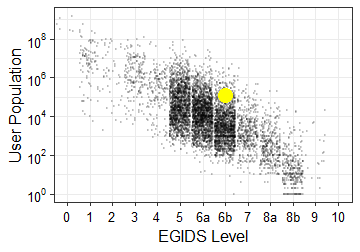cab ISO 639
Garífuna Autonyms
Garifuna
Visualizations
A language of Honduras
- ISO 639
- cab
- Alternate Names
- Black Carib, Caribe, Central American Carib, Garínagu, Karif
- Autonym
- Garífuna
- Population
- 43,100 in Honduras (2013 census), based on ethnicity. 100 monolinguals. Ethnic population: 100,000 (2021 J. Leclerc). Total users in all countries: 119,400.
- Location
- Atlántida and Colón departments; Cortes department: north coast between Masca and Plaplaya in Gracias a Dios department; Islas de la Bahía (Roatan island) department; cities: La Ceiba, Puerto Cortés, San Pedro Sula, and Tegucigalpa; 37 villages.
- Language Status
- 6b (Threatened).
- Classification
- Maipurean, Northern, Maritime, Ta-Maipurean, Iñeri
- Dialects
- Western Garifuna, Eastern Garifuna. Related to Island Carib [crb], with borrowings from Carib [car], Spanish [spa], English [eng], and French [fra]. Eastern Garifuna dialect is spoken in Honduras (leaves out, r, and tends to shorten words), Western Garifuna in Guatemala and Belize.
- Typology
- VSO.
- Language Use
- All domains. Some of all ages. Positive attitudes. A few also use English [eng]. Also use Spanish [spa], with some shifting in some villages.
- Language Development
- Literacy rate in L1: 1%–5%. Literacy rate in L2: 5%–15%. Radio. Dictionary. Grammar. Texts. Bible: 2002.
- Digital Support
- Emerging (0.11).
- Writing
- Latin script [Latn].
- Other Comments
- Ancestors taken from Saint Vincent Island in 1796–1797, and taken to Roatan Island. Most went to Trujillo, Honduras in 1937. About 35 years later political troubles threatened their existence, and they fled further east into Honduras and Belize. Later they emigrated to other countries. Christian, traditional religion.
- Language Resources
- OLAC resources in and about Garifuna
Also Spoken in
- Location
- Belize, Stann Creek, and Toledo districts: 6 villages.
- Dialects
- Western Garifuna.
- Language Status
- 6b (Threatened)
- Other Comments
- Ancestors taken from Saint Vincent Island in 1796–1797, and taken to Roatan Island. Most went to Trujillo, Honduras in 1937. About 35 years later political troubles threatened their existence, and they fled further east into Honduras and Belize. Later they emigrated to other countries. View other languages of Belize
Language Name
Garifuna
User Population
8,440 in Belize (2014 UNSD). Ethnic population: 15,100 (2013 census).
- Location
- Izabal department: Livingston and Puerto Barrios villages; northeast coast.
- Dialects
- Western Garifuna.
- Language Status
- 6b (Threatened)
- Other Comments
- Ancestors taken from Saint Vincent Island in 1796–1797, and taken to Roatan Island. Most went to Trujillo, Honduras in 1937. About 35 years later political troubles threatened their existence, and they fled further east into Honduras and Belize. Later they emigrated to other countries. View other languages of Guatemala
Language Name
Garifuna
User Population
2,860 in Guatemala (2019 census). Ethnic population: 19,500 (2019 census).
- Location
- South Caribbean Coast Autonomous Region: Orinoco village.
- Language Status
- 9 (Dormant)
- Other Comments
- Non-indigenous. Ancestors taken from Saint Vincent Island in 1796–1797, and taken to Roatan Island. Most went to Trujillo, Honduras in 1937. About 35 years later political troubles threatened their existence, and they fled further east into Honduras and Belize. Later they emigrated to other countries. View other languages of Nicaragua
Language Name
Garifuna
User Population
No known L1 speakers in Nicaragua (2012 R. Reeck). Ethnic population: 3,270 (2005 census).
- Location
- California: Los Angeles; Florida: Miami; Louisiana: New Orleans; New York: New York City.
- Language Status
- Unestablished
- Other Comments
- Non-indigenous. View other languages of United States
Language Name
Garifuna
User Population
65,000 in United States (2001 E. Velásquez).

